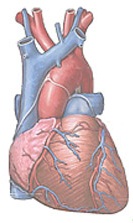 A cocktail of genes could repair the damage left behind after a heart attack by reprogramming cells to switch scar tissue back to healthy heart muscle, and also help grow new blood vessels.
A cocktail of genes could repair the damage left behind after a heart attack by reprogramming cells to switch scar tissue back to healthy heart muscle, and also help grow new blood vessels.
Heart attacks leave the heart weakened and damaged, and the body tries to fix the problem by creating scar tissue. This just doesn't work as well and can lead to long-term problems such as heart failure. Previously, researchers have tried to regenerate heart muscle using pluripotent stem cells, but these come with the potential risk of cancer. Gene therapy has potential as a safer and more effective option, and adding in the gene for vascular endothelial growth factor (VEGF) could give it an extra boost by encouraging blood vessel growth.
To test this, researchers treated rats with three forms of the gene for VEGF, which promotes the growth of new blood vessels; other rats got a dose of an inactive material. Three weeks later, all the rats were treated with a mixture of three transcription factor genes (Gata4, Mef 2c and Tbx5) meant to trigger the process of translating genes into active proteins.
The rats that just got the second stage of therapy, the transcription factor genes, had half the scar tissue of untreated animals and more heart muscle cells, and their hearts worked better. However, the difference was more dramatic for the animals that had both doses of genes--these had an ejection fraction (a measure of how well the heart works) four times greater than that of those who received a single dose. The research was published in the Journal of the American Heart Association.
The tests so far have just been in rat-sized hearts, and so the next step will be to find out if the gene therapy works on larger hearts. If the technique proves feasible, doctors could start treatment soon after heart attacks to correct the muscle damage and improve quality of life for both patients and their families.
In a similar approach, Italian researchers are looking at using microRNAs (miRNAs) to regenerate heart tissue after heart attacks.
- read the press release
- see the paper